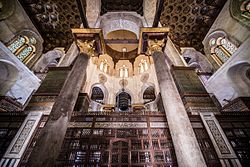Top: Madrasa-Mosque of Sultan Hasan in Cairo, Egypt (1356–1361); Centre: Mausoleum of Sultan Qalawun in Cairo (1285); Bottom: Citadel of Qaitbay in Alexandria, Egypt (late 15th century) | |
| Years active | 1250–1517 (combined with other styles after 1517) |
|---|---|
| Part of a series on |
| Arabic culture |
|---|
 |
Mamluk architecture was the architectural style that developed under the Mamluk Sultanate (1250–1517), which ruled over Egypt, the Levant, and the Hijaz from their capital, Cairo. Despite their often tumultuous internal politics, the Mamluk sultans were prolific patrons of architecture and contributed enormously to the fabric of historic Cairo.[1] The Mamluk period, particularly in the 14th century, oversaw the peak of Cairo's power and prosperity.[2] Their architecture also appears in cities such as Damascus, Jerusalem, Aleppo, Tripoli, and Medina.[3]
Major Mamluk monuments typically consisted of multi-functional complexes which could combine various elements such as a patron's mausoleum, a madrasa, a khanqah (Sufi lodge), a mosque, a sabil, or other charitable functions found in Islamic architecture. These complexes were built with increasingly complicated floor plans which reflected the need to accommodate limited urban space as well as a desire to visually dominate their urban environment. Their architectural style was also distinguished by increasingly elaborate decoration, which began with pre-existing traditions like stucco and glass mosaics but eventually favoured carved stone and marble mosaic paneling. Among the most distinguished achievements of Mamluk architecture were their ornate minarets and the carved stone domes of the late Mamluk period.[4][5][1]
While the Mamluk empire was conquered by the Ottomans in 1517, Mamluk-style architecture continued as a local tradition in Cairo which was blended with new Ottoman architectural elements.[6] In the late 19th century, "Neo-Mamluk" or Mamluk Revival buildings began to be built to represent a form of national architecture in Egypt.[7][8]
- ^ a b Williams 2018.
- ^ Raymond 1993.
- ^ Blair & Bloom 1995, pp. 70, 85–87, 92–93.
- ^ Behrens-Abouseif 2007.
- ^ Blair & Bloom 1995, pp. 70.
- ^ Williams 2018, p. 17.
- ^ Cite error: The named reference
:04was invoked but never defined (see the help page). - ^ Cite error: The named reference
:1was invoked but never defined (see the help page).


